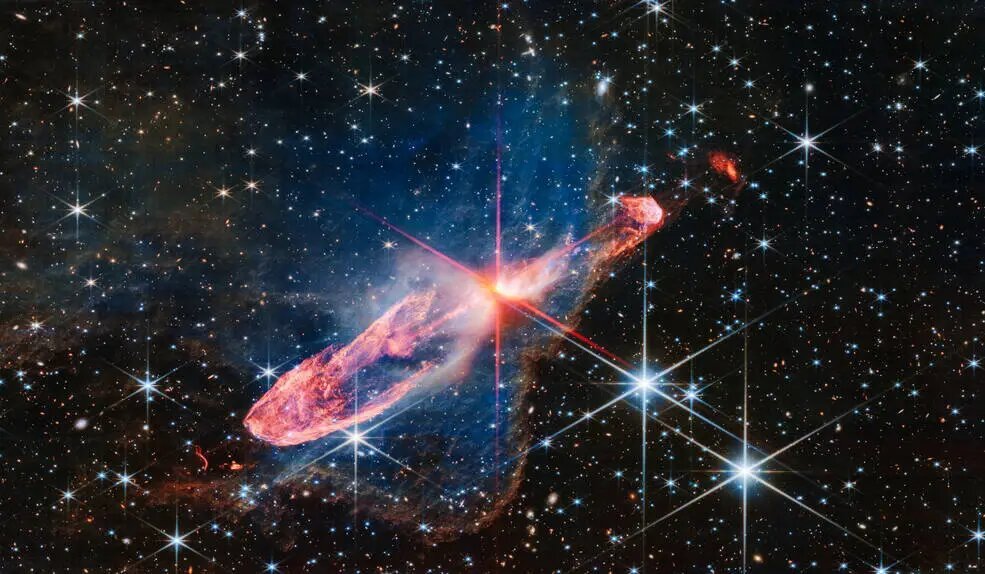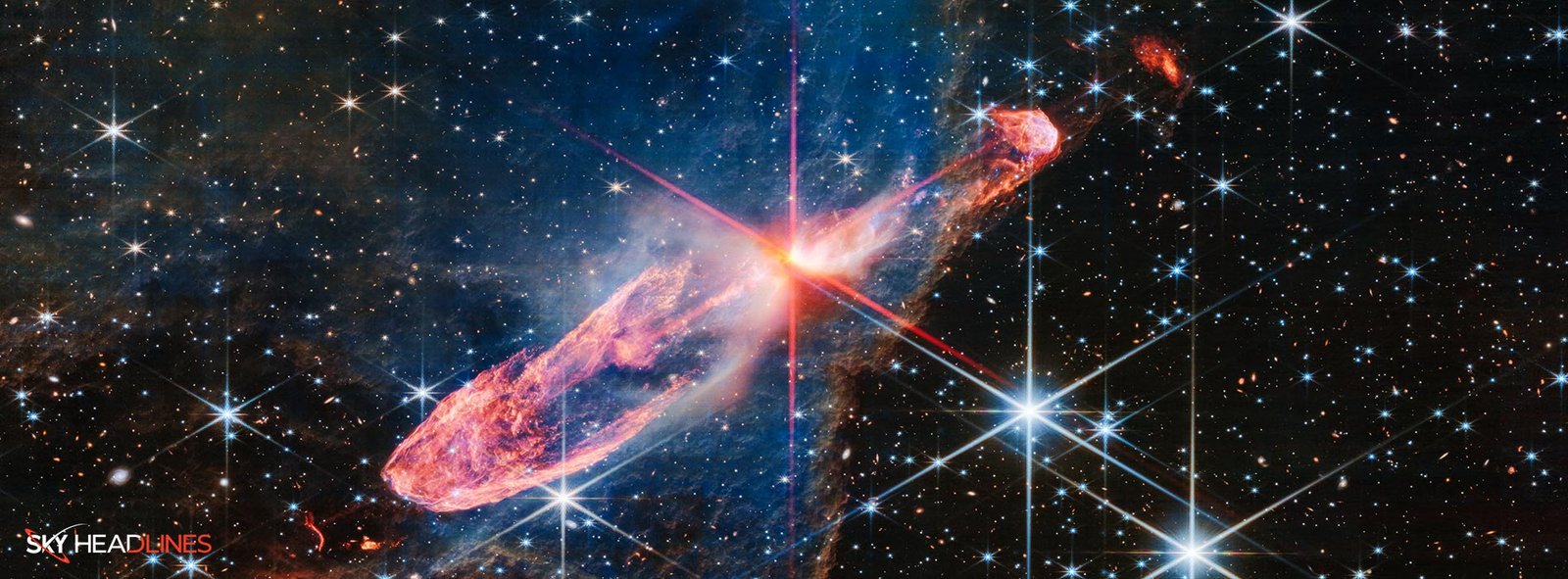James Webb Telescope captured two young stars’ images. These two stars are Herbig-Haro 46/47 and covered in orange-white splotch.

Webb Telescope Captures Stunning Images of Young Stars and Their Fiery Orange Lobes
NASA’s James Webb Space Telescope has captured fascinating images of two young stars, known as Herbig-Haro 46/47, in vivid near-infrared light. To spot them, just follow the bright pink and red spikes until you reach the center, where you’ll find the stars within the orange-white splotch. These stars are surrounded by a hidden disk of gas and dust that fuels their growth as they gain more mass.
What is so cool about the orange-white splotch in which these young stars are covered?
The coolest part is the fiery orange lobes that spread out on both sides from the center stars. This material was shot out from the stars as they swallowed and expelled gas and dust around them over thousands of years.
When the more recent ejections collide with older material, they shape these lobes differently, like turning a big fountain on and off randomly. This creates beautiful billowing patterns, and some jets release more material or move at higher speeds. Why does this happen? It’s probably because of the amount of material that fell onto the stars at specific times.
What are the key features observed in the recent ejections of the blue cloud of Herbig-Haro 46/47?
Let’s take a closer look at the stars’ recent ejections – they show up as thread-like blue lines just below the red spike at 2 o’clock. On the right side, these ejections form wavy patterns with breaks and end in a cool light purple circle within the thick orange area. On the left, we can see lighter blue, curly lines, though sometimes they’re hidden by the bright red spike.
These jets play a crucial role in star formation because they control how much mass the stars gather. The stars are surrounded by a small disk of gas and dust, like a tight band tied around them.
The Effervescent Blue Cloud: Let’s Know More About it!
Now, check out the second most prominent feature: the effervescent blue cloud. It’s a dense region of dust and gas, also known as a Bok globule. In visible light, it appears almost entirely black, but the James Webb Space Telescope’s near-infrared image lets us see through the hazy layers of the cloud. This reveals more of Herbig-Haro 46/47 and even shows distant stars and galaxies beyond it. You’ll notice the nebula’s edges in a soft orange outline, forming a backward L shape along the right and bottom.
What is the significance of the material ejected by young stars in the process of star formation?
The lobes we see are made up of material that the stars once swallowed from the dusty disk around them and then later expelled into space. These ejections play a vital role in the process of star formation. Picture them like a fountain, quickly turning on and off, creating beautiful patterns in the cosmic pool. Once these young stars finish growing, they will bring order to this chaotic scene.
In the background, you can’t help but notice the vast collection of stars and galaxies scattered across our universe. Each one, whether old or new, big or small, holds its significance in the vast expanse we call home.
What does the vast collection of stars and galaxies reveal about our universe?
Galaxies offer insights into the organization of matter on cosmic scales, providing valuable information to comprehend the universe’s nature and history. Scientists analyze both the present arrangement and the changes in organization across cosmic time to gain a deeper understanding of these fundamental processes.
What is the significance of the nebula in shaping the jets from the central stars?
Let’s explore the significance of the nebula in shaping the jets from the central stars. When the ejected material collides with the nebula on the lower left, it creates opportunities for the jets to interact with molecules in the nebula, causing both to light up.
Now, look at two other areas to compare the lobes’ asymmetry.
- In the upper right, you’ll notice a blobby, sponge-shaped ejecta that appears separate from the larger lobe. Only a few semi-transparent wisps of material point toward the larger lobe, and there are almost transparent, tentacle-like shapes drifting behind it, like cosmic streamers.
- On the lower left, beyond the hefty lobe, you’ll find an arc. Both the blob and the arc consist of material pushed farthest, possibly from earlier ejections. The arcs seem to point in different directions, suggesting they may have come from different outflows.
Take a closer look at the image. Although it seems like Webb captured Herbig-Haro 46/47 edge-on, one side is slightly closer to Earth, surprisingly the smaller right half. The left side, even though it’s larger and brighter, is pointing away from us.
Why Webb Space Telescope’s image of this cosmic nebula is so exceptional?
Throughout millions of years, the stars in Herbig-Haro 46/47 will fully form. And the stunning, colorful ejections we see now will eventually disappear. The binary stars will then become the main focus against a background filled with galaxies.
The James Webb Space Telescope (JWST) reveals such intricate details of Herbig-Haro 46/47 for two reasons.
- Firstly, the object is relatively close to Earth.
- Secondly, the telescope’s image is a combination of multiple exposures, adding depth to the picture.
Located 1,470 light-years away in the Vela Constellation, Herbig-Haro 46/47 is a cosmic nebula—a huge cloud of dust and gas. JWST’s special capabilities allow us to see through this haze and study what’s inside. Which is providing the most detailed portrait of these stars to date. The nebula is the reason why the stars’ jets appear to light up. As ejected material collides with the nebula on the lower left, it takes on wider shapes due to interactions with molecules within the nebula.
The image we have now is a sparkling spectacle, worth more than a thousand words. Even with all the information we’ve discussed, astronomers believe there’s still so much more to learn. They also believe about how stars form from this extraordinary picture.





